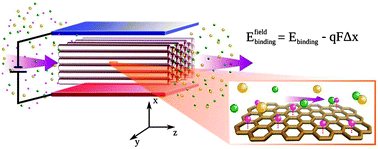Potential energy surface and binding energy in the presence of an external electric field: modulation of anion–π interactions for graphene-based receptors†
Abstract
Measuring the binding energy or scanning the potential energy surface (PES) of the charged molecular systems in the presence of an external electric field (EEF) requires a careful evaluation of the origin-dependency of the energy of the system and references. Scanning the PES for charged or purely ionic systems for obtaining the intrinsic energy barriers needs careful analysis of the electric work applied on ions by the EEF. The binding energy in the presence of an EEF is different from that in the absence of an electric field as the binding energy is an anisotropic characteristic which depends on the orientation of molecules with respect to the EEF. In this contribution we discuss various aspects of the PES and the concept of binding energy in the presence of an EEF. In addition, we demonstrate that the anion–π bonding properties can be modulated by applying a uniform EEF, which has a more pronounced effect on the larger, more polarizable π-systems. An analogous behavior is presumed for cation–π systems. We predict that understanding the phenomenon introduced in the present account has enormous potential, for example, for separating charged species on the surface of polarizable two-dimensional materials such as graphene or the surface of carbon nanotubes, in desalination of water.


 Please wait while we load your content...
Please wait while we load your content...